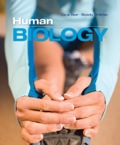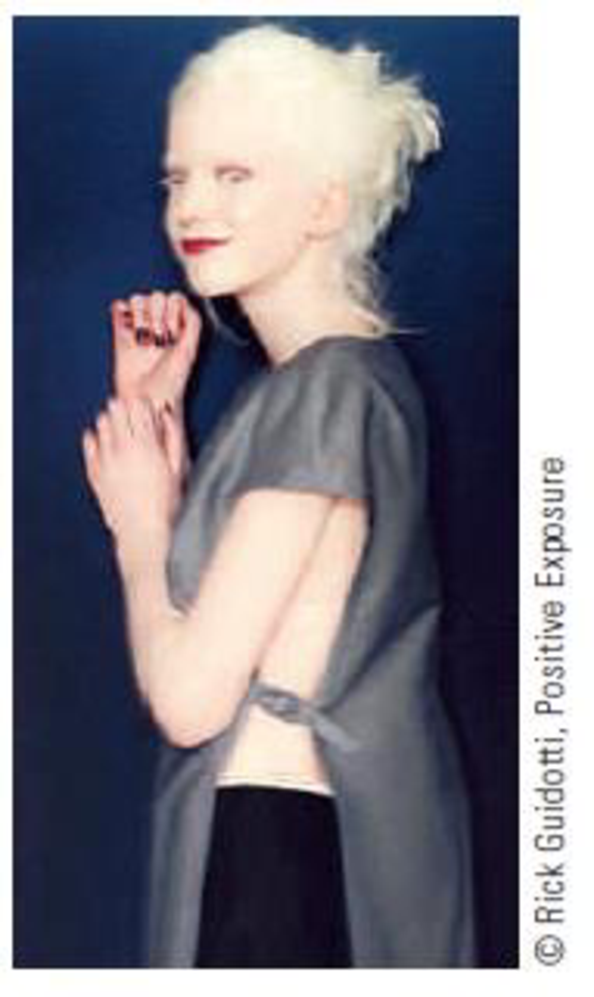
EBK HUMAN BIOLOGY
11th Edition
ISBN: 8220100545931
Author: MCMILLAN
Publisher: Cengage Learning US
expand_more
expand_more
format_list_bulleted
Concept explainers
Textbook Question
Chapter 19, Problem 4CT
The young woman shown at right has albinism—very pale skin, white hair, and pale blue eyes. This phenotype is due to the absence of melanin, which imparts color to the skin, hair, and eyes. It typically is caused by a recessive allele. In the following situations, what are the probable genotypes of the father, the mother, and their children?

- a. Both parents have normal
phenotypes ; some of their children are albino and others are not. - b. Both parents and all their children are albino.
- c. The mother is not albino, the father is albino, and one of their four children is albino.
Expert Solution & Answer
Trending nowThis is a popular solution!

Students have asked these similar questions
A homozygous recessive allele, aa, is responsible for albinism. Humans can exhibit this phenotype. In each
of the following cases, determine the possible genotypes of the mother and father, and of their children:
(a) Both parents have normal phenotypes; some of their children are albino and others are unaffected:
(b) Both parents are albino and have only albino children:
(c) The woman is unaffected, the man is albino, and they have one albino child and three unaffected children:
at a busy hospital. The son of the first couple has hemophilia, a recessive, X-linked
Two mothers give birth to sor
disease. Neither parent from couple #1 has the disease. The second couple has an unaffected son, despite the fact
that the father has hemophilia. The two couples challenge the hospital in court, claiming their babies must have beer
swapped at birth. You must advise as to whether or not the sons could have been swapped. What would you say?
5. In a dispute over parentage, the mother of a child with…
The allele for albinism is recessive to the allele for normal skin pigmentation. All individuals who are homozygous for this recessive allele (m) are unable to produce the enzyme needed for melanin production and are referred to as albinos. In the following statements, determine the correct genotypes: An albino male (genotype A) whose parents both have normal skin pigmentation (genotype B) marries a woman who does not have albinism (genotype C). This woman’s father is an albino (genotype D). The married couple has three children, two with normal skin pigmentation (genotype E) and one exhibiting albinism (genotype F)
Albinism causes the skin, hair, or eyes to have little or no color. It is also associated with vision problems. Albinism results from an allele a that is recessive to the allele for normal melanin production. Maya has normal skin color, but her sister has albinism. Maya’s mother has albinism, and her father has normal skin color.
a)What are the genotypes of Maya, her sister, her mother, and her father.
b)If Maya’s parents have another child, what is the probability that this child will have albinism? Show the Punnett square you use to help in solving.
c)If Maya marries a man with albinism, what is the probability that their first child will have albinism? Show the Punnett square you use to help in solving.
Chapter 19 Solutions
EBK HUMAN BIOLOGY
Ch. 19 - Define the difference between (a) gene and allele,...Ch. 19 - Prob. 2RQCh. 19 - What is probability, and how is it applied in...Ch. 19 - What is independent assortment? Does independent...Ch. 19 - Alleles are ___________. a. alternate forms of a...Ch. 19 - A heterozygote has _____. a. only one of the...Ch. 19 - Prob. 3SQCh. 19 - Offspring of a cross AA aa are ______. a. all AA...Ch. 19 - Prob. 5SQCh. 19 - Prob. 6SQ
Ch. 19 - Which statement best fits the principle of...Ch. 19 - Prob. 8SQCh. 19 - Prob. 9SQCh. 19 - Prob. 10SQCh. 19 - One gene has alleles A and a. Another has alleles...Ch. 19 - Still referring to Problem 1, what will be the...Ch. 19 - Go back to Problem 1, and assume you now study a...Ch. 19 - The young woman shown at right has albinismvery...Ch. 19 - When you decide to breed your Labrador retriever...Ch. 19 - The ABO blood system has been used to settle cases...Ch. 19 - Prob. 7CTCh. 19 - A man is homozygous dominant for ten different...Ch. 19 - Prob. 9CTCh. 19 - Bill and Marie each have flat feet, long...Ch. 19 - You decide to breed a pair of guinea pigs, one...
Knowledge Booster
Learn more about
Need a deep-dive on the concept behind this application? Look no further. Learn more about this topic, biology and related others by exploring similar questions and additional content below.Similar questions
- There are four blood types: A, B, AB, and O. However, there are three alleles that control blood types: IA, IB, and i. Alleles IA and IB are codominant, and the allele "i" is recessive. What are the two genotypes for type A blood? What are the two genotypes for type B blood? What is the one genotype for type AB blood? What is the one genotype for type O blood? 1.arrow_forwardCystic fibrosis (CF) is an autosomal recessive trait. A three-generation pedigree is shown below for a family that carries the mutant allele for cystic fibrosis. Note that carriers are not colored in to allow you to figure out their genotypes. Normal allele = F CF mutant allele = f What is the genotype of individual #13? A) ff B) FF C) Ff D) it is impossible to tellarrow_forwardAlbinism, lack of pigmentation in humans, results from an autosomal recessive gene designated a. Two parents with normal pigmentation have an albino child. What is the probability that their next child will be albino? What is the probability that the next child will be an albino girl? If the child is normal, what is the probability that it will be a carrier (heterozygous) for the albino gene?arrow_forward
- In man, muscular dystrophy is a condition in which the muscles waste away during early life and may result in a shorter life expectancy. It is due to a sex-linked, recessive gene. A certain couple has five children – three boys (ages 1yr, 3yrs, and 10yrs old) and two girls (ages 5yrs and 7yrs old). The oldest boy shows the symptoms of this disease. You are their family physician and they come to you for advice. What would you tell them about the chances of their other children developing the disease?arrow_forwardThe allele for albinism ( c ) is recessive to the allele for normal pigmentation ( C ). A normally pigmented woman whose father is an albino marries an albino man whose parents are normal. They have three children, two normal and one albino. Give the genotypes for EACH person listed.arrow_forwardThe gene for polydactyly (P) is autosomal and dominant to normal fingers (p). Hemophilia is sex-linked and recessive (X h ). A man and his wife both of whom are polydactylous and have normal red blood cells have a child who is non-polydactylous and with hemophilia. What are their genotypes?arrow_forward
- Epilepsy is a central nervous system (neurological) disorder in which brain activity becomes abnormal, causing seizures or periods of unusual behavior, sensations and sometimes loss of awareness. For epilepsy, the concordance values are 72% for monozygotic twins and 15% for dizygotic twins. 1) Is this a single gene inheritance or multifactorial disease? 2) Is there a strong genetic or environmental cause to the development of this disease? If both genetic and environmental causes are implicated, you have to indicate each of them separately.arrow_forwardFor a recessive condition, two normal heterozygous individuals have children. What is the likelihood of their children being affected by this condition? What is the likelihood of their children being carriers without the condition? What is the likelihood of their asymptomatic children being carriers? Suppose that an individual with the condition has children with a heterozygous individual, what is the likelihood of their children being carriers?arrow_forwardX‑linked, recessive diseases, such as hemophilia, are extremely rare in the population. However, many women are carriers and show no sign of the disease. The pedigree illustrates the inheritance of an X‑linked, recessive disease. Determine whether the unknown individuals are affected by the disease, unaffected by the disease, or carriers of the X‑linked recessive allele. Unaffected individuals are not carriers of the X‑linked recessive allele.arrow_forward
- 1. A) Apply the concept of sex linkage to explain why color blindness is more prevalent in men than in women. B) Mary is concerned that she may be a carrier for hemophilia, a sex-linked condition located on the X chromosome. Mary is married to John, who doesn't have hemophilia. Assuming Mary is a carrier, what are the genotype ratios expected for Mary and John's kids (specify for boys and for girls)? C) Mary and John have 2 boys, none of them has hemophilia. Can we use this fact as proof that Mary does not carry the allele for hemophilia? Explain your argument.arrow_forwardA gene that controls the ability to see red and green is located on the X chromosome but not on the Y chromosome. There is a recessive nonfunctional allele for this gene that can cause red-green color blindness if the person possessing it does not also have the dominant normal gene. Consider the case of a carrier mother who is heterozygous for the red-green vision gene and a father who has normal vision. Use XB = normal vision, Xb = color-blind vision. What is the chance the parents would have a color-blind boy? A color-blind girl? What about a girl or boy with normal vision? Redo the Punnett square for a carrier mother (XBXb) and a color-blind father (XbY). Do the chances of having color-blind children change? How?arrow_forwardCystic fibrosis in humans is caused by a recessive allele. A man is known to be a carrier of the cystic fibrosis allele. He marries a phenotypically normal woman. In the general population, the incidence of cystic fibrosis at birth is approximately 1 in 1,700. Assume Hardy-Weinberg proportions. What is the probability that the wife is also a carrier? Answer in decimal number only (three decimal places; example: 0.123). What is the probability that their first child will be affected? Answer in decimal number only (three decimal places; example: 0.123).arrow_forward
arrow_back_ios
SEE MORE QUESTIONS
arrow_forward_ios
Recommended textbooks for you
 Human Biology (MindTap Course List)BiologyISBN:9781305112100Author:Cecie Starr, Beverly McMillanPublisher:Cengage Learning
Human Biology (MindTap Course List)BiologyISBN:9781305112100Author:Cecie Starr, Beverly McMillanPublisher:Cengage Learning

Human Biology (MindTap Course List)
Biology
ISBN:9781305112100
Author:Cecie Starr, Beverly McMillan
Publisher:Cengage Learning
Mitochondrial mutations; Author: Useful Genetics;https://www.youtube.com/watch?v=GvgXe-3RJeU;License: CC-BY